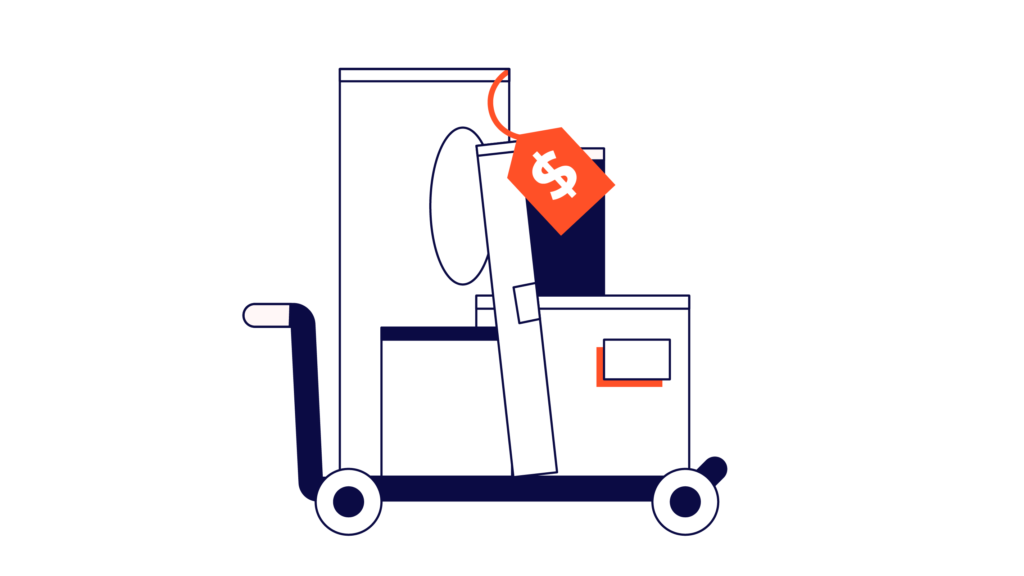If you're looking to stir up some attention for your business, a solid demand generation strategy will help you build an audience and generate excitement around your brand.
If someone walked up to you on the street and suddenly shouted at you, “Hey! Buy my magical supplement. It cures all!” You would probably say, “I don’t believe you. Leave me alone!” That’s also true for new B2B ecommerce brands with pushy ad tactics. You must build a relationship based on trust and establish authority in your niche.
Demand generation is a critical component to your B2B ecommerce brand’s success amidst growing competition and lower barriers to entering the market. On top of that, with the explosion of new channels to transmit a marketing message, it becomes vital to get strategic with your sales and marketing efforts. A comprehensive demand generation strategy will help to position your brand, establish authority, and generate more leads without throwing money down the drain.
As a B2B and startup marketer who has managed several demand generation programs, I will share proven strategies and tactics you can use to build a winning demand gen strategy.
What Is Demand Generation?
Demand generation is the linchpin of B2B ecommerce brand’s marketing strategy because it focuses on building a scalable engine that creates reliable awareness and interest amongst your audience, resulting in a sales funnel with high-quality leads.
Demand gen can make a brand’s marketing messages sound more authoritative and carry more weight with its target market, and ultimately help increase the bottom line by cultivating strong leads that turn into new customers.
Demand gen aims to provide sales with more warm and qualified leads than leads derived from traditional inbound marketing tactics. Demand gen is vital for B2B companies that sell sophisticated or highly technical products with a longer sales cycle because you need to establish credibility. Why should your prospect invest in you over a competitor?
When done right, demand gen aligns sales and marketing teams to build demand for a product/service and clarifies how to do it for every step of the buyer journey.
Demand Generation vs. Lead Generation: What’s the Difference?
Lead generation
Lead generation is a marketing activity that focuses on turning members of an engaged audience into leads. A lead is someone who has an interest in your brand’s products and services. Leads can be categorized as either “marketing qualified leads” or “sales qualified leads” based on how well they fit the criteria for a qualified buyer and their likelihood to enter a sales deal.
For example, lead generation occurs when a business development representative (BDR) sends a personalized follow-up email to a prospect who recently attended a webinar, offering a free trial. If they accept the free trial, they may be categorized as a marketing-qualified lead and be passed on to sales, who will try to convert the lead into a paid customer.
Demand generation
Demand generation, on the other hand, encompasses not only lead generation but also the entire content strategy and activities needed to build an audience within your demographic and total addressable market (TAM). It involves creating a data-driven marketing funnel and optimizing it over time to engage new leads.
Demand gen requires heavy collaboration and communication between sales and marketing departments. It starts earlier in the buyer’s journey than lead gen because it helps to create awareness about:
- The problem you solve.
- How you solve it.
- Why buyers should trust/choose you.
Why Do New Brands Need a Demand Generation Strategy?
Meet buyers where they are in their journey
A decade or two ago, B2B buyers had far fewer sources of information when it came down to purchasing products online. Thanks to search engines like Google and communities like Reddit, key information has been democratized and decentralized. Whereas companies used to rely on industry analysts like Gartner and Forrester to share their in-depth reports, buyers can now engage directly with other buyers and customers.
Due to the increased streams of information available, the buyer journey is a lot more complicated these days. Marketing teams need to think long-term to orchestrate plays that produce high-quality leads across dozens of touchpoints using the right call-to-action at the right time.

Increase brand awareness
Top-of-funnel awareness is critical to building your brand over time. Think back to the Marketing Rule of 7, which says that a message needs to be heard at least seven times to be effective. The more times someone comes across your brand, the more likely they are to think back to it when facing a problem you can solve.
Demand gen puts systems in place to keep your brand in front of your audience and nurture prospective buyers.
Build relationships and trust
A key element of demand generation is establishing authority and credibility in your space. Target buyers will trust you more when you provide value for free, align your brand with topical experts, and showcase customer success stories. This is because you can show what you know and are capable of instead of just telling.
The more consistently you drive these marketing components into your demand gen strategy, the greater the trust will be.
Generate more leads and revenue
Building awareness, capturing and nurturing leads, and prompting engagement through a deliberate demand generation strategy is essential to driving revenue. A robust demand generation strategy will help you bring in reliable, high-quality leads and grow your business.
You’ll reduce wasted marketing spend, increase lead quality, and consistently hit your quotas.
Reduce customer churn
Retaining customers is far more profitable than replacing them. Demand generation helps to better educate prospective buyers about your product, so they are more informed and likely to make the right choice at checkout. Since they are more confident of your product’s ability to deliver, the likelihood of churning is lower.
Laying the Foundation for Your Demand Generation Strategy
Now that we’ve established what demand generation is and why it’s essential for B2B ecommerce brands, we need to cover the foundation for your strategy before diving in.
There are three things (minimum) you need to take care of before building your demand generation strategy: positioning, success metrics, and tools and processes.
Positioning
Hopefully, before you even started to market your product or service, your team put a lot of thought and energy into positioning your product in the market. A positioning statement should be a sentence or two that clearly defines the problem you're solving, for who, and why your solution is compelling.
Here is a real-world example of Harley Davidson’s positioning statement:
“The only motorcycle manufacturer that makes big, loud motorcycles for macho guys (and “macho wannabes”) mostly in the United States who want to join a gang of cowboys in an era of decreasing personal freedom.”
Positioning work is essential to ALL marketing because it provides guidelines for building your brand and crafting your messaging. It’s the stake you claim and your brand’s point of view.
Plan how to measure success
Fortunately, demand generation is not as nebulous as branding. It can often be measured quantitatively.
Start by asking yourself, “What’s the main objective of our demand gen efforts?”
Do you want to pump out leads? Well, first of all, how do you define a lead? What is a conversion event to you?
Once you’ve answered those questions, determine how you’ll measure your demand generation strategy’s effectiveness. You might decide on KPIs or metrics like cost per lead (CPL), deal close rate, funnel conversion rates, time to close (TTC), average contract value (ACV), etc.
Configure tools and processes
Demand generation aims to build a sales pipeline by capturing demand and converting leads. You will need to have a website that is capable of both! For example, ensure you set up your pricing page with the ability to buy now or book a demo. To capture demand, you should also have a newsletter subscription form in your website footer to nurture those who are interested but not yet ready to buy.
You’ll need the right tools to capture email subscribers, run lead nurturing programs, and facilitate sales. Use the right ecommerce customer relationship management (CRM) software with email automation capabilities to engage with your subscribers and leads.
4 Demand Generation Strategy Best Practices New Brands Should Implement
Best practice #1: Establish your brand’s authority
Remember the imaginary guy who yelled at you about his magic supplements? Don’t be that guy! Establishing your brand’s authority is fundamental for instilling trust.
Unless you sell commodities, you need to build authority and answer these questions to generate demand for your product:
- Why did you create your product or service?
- What does it offer that no one else does?
- Why should people care?
- Are you an expert in your buyers’ problems?
The first four tactics will help with this demand generation strategy:
Educate with content
According to the 2022 Demand Generation Benchmark Survey, 58% of respondents indicated they will increase their content marketing budget prioritization.
Marketers prioritize content because it is the central part of any B2B demand generation strategy. That’s because, before you can sell your “magic supplements,” you need to explain why people need them. And there is no better way to do it than content.
So, what is content marketing?
The Content Marketing Institute states, “Content marketing is a strategic marketing approach focused on creating and distributing valuable, relevant, and consistent content to attract and retain a clearly defined audience — and, ultimately, to drive profitable customer action.”
Through content paired with SEO, you can answer your ideal customer’s questions at every stage of the buyer journey:
Example of a Content Marketing Funnel
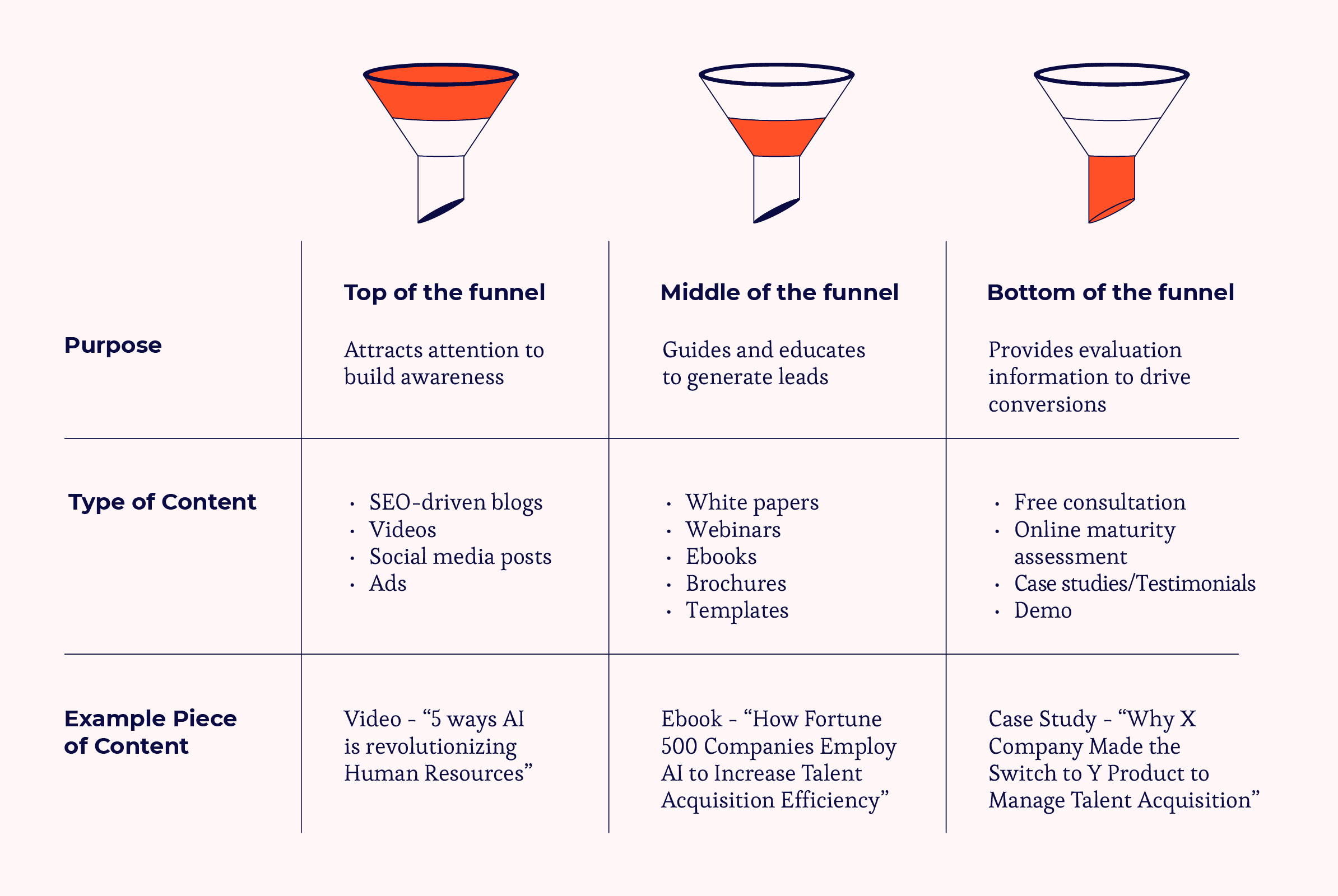
To learn more about content marketing, check out this guide I wrote on how you can create your content marketing plan in 8 steps.
Expand your audience with content distribution
Content distribution is a way to reach a larger audience with your content and get it in front of more ideal customers where they “hang out” online. Think about where they go when they’re looking to learn about best practices and ensure you’re brand’s voice is represented there.
Say, for example, you are selling case management software to lawyers and wrote an article about the newest trends in legal tech. You might want to approach an online legal trade magazine and ask them to include it in its upcoming newsletter. Or you might share the article in LinkedIn groups for lawyers.
An effective content distribution campaign should involve:
- Re-purposing content and adapting it to new formats.
- Targeted outreach to decision-makers.
- Increasing reach by leveraging distribution platforms.
- Promoting content with ads.
Build authority with event marketing
Another common tactic for demand generation is hosting an event. Whether a conference (virtual or IRL), seminar, meetup, or webinar, B2B ecommerce brands can leverage events to establish authority. By inviting people in your target market to learn from you, you provide them with value. It will further establish your brand as the go-to source for information and solutions.
One of the pinnacle examples of event marketing in B2B is Salesforce’s Dreamforce event, which draws in hundreds of thousands of attendees and A-list performers each year. For new brands without that budget (Yet!), think about hosting local meetups, panel discussions, and webinars.
Collaborate with non-competitive brands
One of the best ways to build brand awareness and authority quickly is to partner with other well-established brands. By association, your brand will become more trustworthy.
The collaboration could be in producing helpful content, starting a podcast, or co-hosting an event. The key is to find a brand whose values are in sync with yours, is not a direct or indirect competitor, and shares the same audience as you. This will ensure that there is a win-win opportunity for everyone.
A great example of collaboration or partner marketing is Boostup’s Revenue Master Class series. In each webinar, the revenue operations platform teams up with high-value brands like the venture capital firm Insight Partners and Datadog to provide their shared audience with valuable tips.

Best practice #2: Provide unparalleled value—for free
As mentioned earlier, a key element of demand generation is to provide value before you sell anything. In doing so, you improve brand awareness, establish authority, and capture demand.
The next four tactics describe ways to provide more value for prospective customers to win them over.
Build a community with a capital C
Community marketing is one of the hottest topics in B2B marketing. The new evolution of it (what I’d call Community 2.0) goes beyond marketing to your community of customers and social media followers. Instead, it’s Community marketing with a capital “C” where connections are encouraged over transactions.
Harvard Business Review says, "If a company can transition from simply delivering a product to building a community, it can unlock extraordinary competitive advantages, and both create and support a superior business model."
A vibrant Community is a value-add that establishes thought leadership and market dominance. Community nurtures and produces the highly qualified leads that convert—mainly because they were acquired through an exchange of value rather than merely clicking an ad.
Lastly, a good community is like a moat around your brand. It is hard for competitors to replicate a strong, active, and passionate community. Think of Salesforce and its Trailblazer community or Sephora and its Beauty Insider Community (which, at the time of this writing, has 5,628,461 members).
How do you build a community?
Community starts with an online hub that serves as a forum and virtual meetup place. Community marketing involves sharing and promoting content in your hub, hosting meetups, sparking thoughtful conversations, forging connections, and more.
You may want to have a community manager who invites and welcomes members to the community and works to find more ways the community can provide value to its members.
Develop a proprietary tool
Another genius way to provide value is creating a tool your ideal customer may find helpful. For example, SetSail has created an ROI calculator that helps prospects understand the potential return on investment they’d obtain if they use their software.
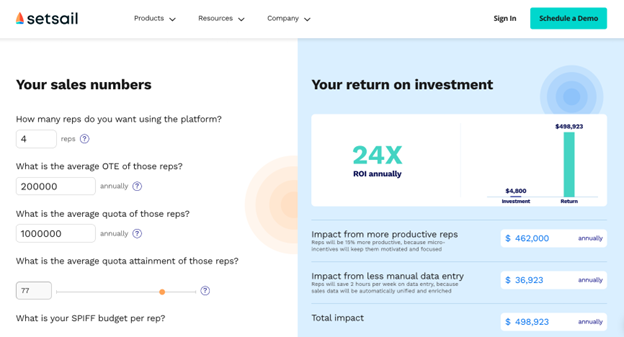
Other famous examples of free tools include Hubspot’s website grader and Ahref’s website authority checker.
Produce an ultimate How-To Guide
A staple in content marketing that is an important tactic for giving away value before you sell is How-To Guides. The key is to make them more up-to-date, relevant, in-depth, and helpful than any other guide. This will help you win in the reader's mind and also outrank the competition on Google.
By creating a How-To Guide, you’re helping your target audience to solve their problem. By the same token, you build topical authority and educate them about your product's unique value. Once you create the guide, publish it on your website (you can gate it or leave it ungated) and promote it with your content distribution system.
Here is an example of a How-To Guide I helped create for product portfolio management platform, Dragonboat, which received over 1,000 downloads in the first 3 months:
🚀 What do industry leaders like PayPal, Miro, eBay, & Shutterfly have in common?
— Dragonboat (@dragonboat_io) April 26, 2022
For one, they successfully utilized #productoperations to accelerate product portfolio outcomes.
Want to learn how you can too?
Download the Product Ops Playbook: https://t.co/lXsobHGOYA pic.twitter.com/pNL7JjAAyD
Partner with aggregator and review websites
The last tactic to add value, but one of the most important, is to work with aggregator and product review websites. In the world of B2B ecommerce, competition to rank on the first page of Google is increasingly cut-throat.
It’s tricky because you are not only competing with your competitors but also aggregators, review sites, and listicles. For example, when you type “best shipping company for ecommerce” into Google, you will see several articles like this:
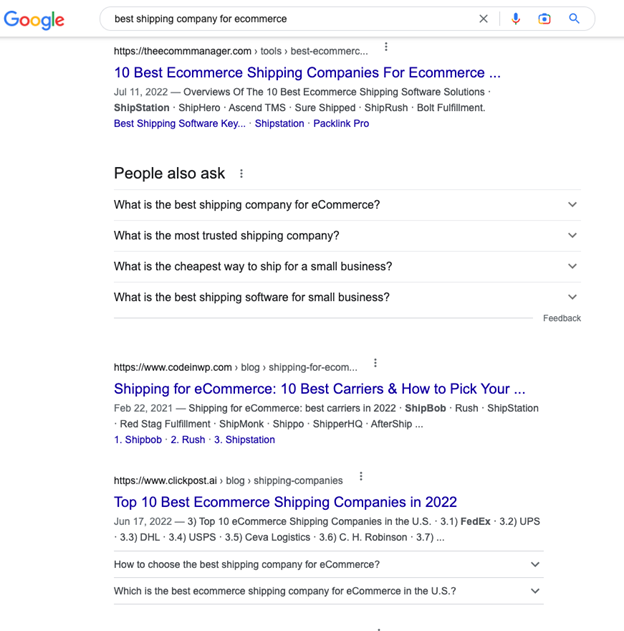
If you’re a new B2B ecommerce brand, your best bet is to join them, not fight ‘em!
Reach out to the content managers of these websites and ask them to include your brand. By working with these sites, you increase the mutual value because you are making their content more complete while they, in turn, promote your product in the top search rankings.
Best practice #3: Build a smart nurture engine
While strategies #1 and #2 deal with building awareness and providing value, strategy 3 focuses on capturing interested potential buyers and nurturing them.
This strategy corresponds to the middle of your marketing funnel. If you neglect this area, the effort you spend to drive top-of-funnel awareness will go to waste.
Consider these next four tactics for your mid-funnel demand generation strategy.
Create a weekly newsletter
Although it’s been said many times, email is not dead. Email marketing revenue is estimated to reach almost $11 billion by the end of 2023.
It is fundamental for B2B ecommerce brands to send regular newsletters to their subscribers filled with their latest content, product updates, events, news, and more. By creating a weekly or monthly email newsletter, your brand will maintain top-of-mind awareness and continue to provide value to your audience.
Use conversational marketing (aka chatbots)
Sophisticated B2B buyers are becoming accustomed to interacting with chatbots to get the info they need from a brand’s website more quickly. They are seen as more helpful and less cumbersome than filling out a contact form. According to Drift’s 2021 State of Conversational Marketing Report, 27% more B2B buyers expressed frustration with old-school forms in 2021 than in 2020.
While they’re more fun than forms, using chatbots for conversational marketing is instrumental in qualifying leads and driving demand. For example, if someone visits your pricing page, you can use the chatbot to ask them if they have any questions. The chatbot can send them a link to your FAQ page if they ask a common question. Or, if appropriate, they can invite the prospective buyer to sign up for a free trial.
Configure automated nurture emails
Once you have leads in your marketing funnel, it is important to nurture them in an ongoing, automated way. This is where automated nurture email campaigns come into play.
For example, if someone downloaded your “How-To Guide,” it means they are most likely in the awareness or interest phase of the buyer’s journey. Since they're not ready to buy, you can follow up with an email containing supplemental resources to continue to provide value. You can progressively send them content that moves them down the funnel.
Tools like HubSpot, Salesforce, MailerLite, ActiveCampaign, etc. are ideal for creating these automated nurture campaigns.
Use highly targeted ads
Advertising on LinkedIn and Google is an essential element for any B2B eCommerce demand generation strategy.
On LinkedIn, you can customize your target audience by firmographic criteria like size, industry, location, etc. If you already have specific companies in your sales pipeline, you can specify those exact company names.
With Google, you can run display or search ads to promote your best content. For example, you can run search ads targeting relevant keywords that point to a landing page for a How-To Guide or webinar. Offer them the resource in exchange for their email.
Then, you can take it a step further by retargeting those leads using display ads which usually have relatively low CPMs. The critical thing to remember with ads is that the more targeted, the higher the potential ROI and the fewer wasted dollars.
Best practice #4: Partner closely with sales to close bigger, better deals
Lastly, your demand generation strategy would only be complete by incorporating a plan for increasing conversions and enabling sales to close high-value deals.
The last four tactics I’ll share for demand generation deal with how marketing and sales can work together.
Publish compelling case studies
Let’s say a lead is excited about your product and its features, but they need more evidence that it is the best option. To give them that extra assurance, you can share bottom-of-the-funnel content like customer reviews and case studies.
A case study should be in the format of a web page or a PDF that tells the story of your customer’s business context, challenge (pain point that led them to buy your product), solution (how they implemented your product, be specific), and results. It should include quotes from your customer and both qualitative and quantitative results. Keep it concise and skip the jargon.
Equip your sales team with case studies that revolve around your product’s different use cases, industries that it serves, and buyer personas. To get the most out of your efforts, have an open dialogue with sales to understand if they are using the case studies and if they believe they were effective.
Here are some examples of compelling case studies:
- How Gong Empowers Clearbit to Be More Proactive Around Customer Needs
- How Pendo Reduced Their Cost-per-MQL on Facebook by 80%
- Tealium Builds and Scales Product Operations with Dragonboat’s Single Source of Truth
Implement lead scoring
Let’s say you created a How-To Guide that has generated thousands of downloads and new email subscribers. A mistake that marketers often make is assuming that all of these contacts are leads. In reality, you might have had one unqualified lead (like a student who downloaded it while researching for their term paper) for every qualified lead.
Lead scoring can help to discern which of these subscribers are MQLs that should be nurtured and which are not worth focusing on. A lead score is a value you can assign to a contact based on multiple attributes, including the professional information they've shared and how they've engaged with your website and brand across the web.
By using a system to score leads, you can help sales prioritize them, respond to them appropriately, and increase the rate at which they convert into customers.
Work with sales on account-based marketing
Building on the idea of lead scoring, you can also score companies and/or accounts. Account-based marketing (ABM) is a tag-team approach where sales and marketing qualify companies and partner closely to drive demand within them and close at higher rates.
Once you have worked with sales to build a list of targeted accounts, you can target those accounts with a mixture of demand-gen tactics like PPC ads, email, events, and LinkedIn outreach.
ABM is an excellent tactic for demand generation because it allows you to personalize the sales process and ensure your sales team has all the information they need to close the sale.
Incorporate intent data
Finally, optimize your ABM efforts and demand gen campaign performance by leveraging intent data to realize an even greater ROI.
Intent data is a type of sales intelligence that shows which prospects or companies are actively researching on third-party sites. When buyers face a problem, they consult the internet to find a solution and often narrow their options before a salesperson can speak with them. Intent data indicates when a prospect has started to research products shortly after they began the process (when there is still time to be proactive and reach out to them first).
You can use a tool like ZoomInfo Intent to find accounts that research topics relevant to your business through the online consumption of:
- Product ratings and reviews
- Blog articles
- Product comparisons
- Message boards like Quora
- Case studies
- General news
If you can collect and use online intent data, you can reach buyers much earlier in the process, guiding their decision-making before a competitor catches on. This form of sales intelligence represents a huge opportunity for forward-thinking ecommerce brands. Insights from this data can reduce customer acquisition costs, shorten sales cycles, identify cross-selling and upselling opportunities, improve conversions, etc.
Drive Demand to Strengthen Your Brand and Boost Revenue
I hope by now you have understood the importance of having a successful demand generation strategy for your B2B ecommerce brand.
In today’s increasingly complex world, where potential customers’ attention can go to so many different channels every day, it’s essential to know how you can cut through the noise and drive demand for your product. You can help your brand attract ideal customers and increase revenue by cultivating highly qualified leads.
To sum up the meat and potatoes of this post, here are four demand generation strategies and corresponding tactics you can use today:
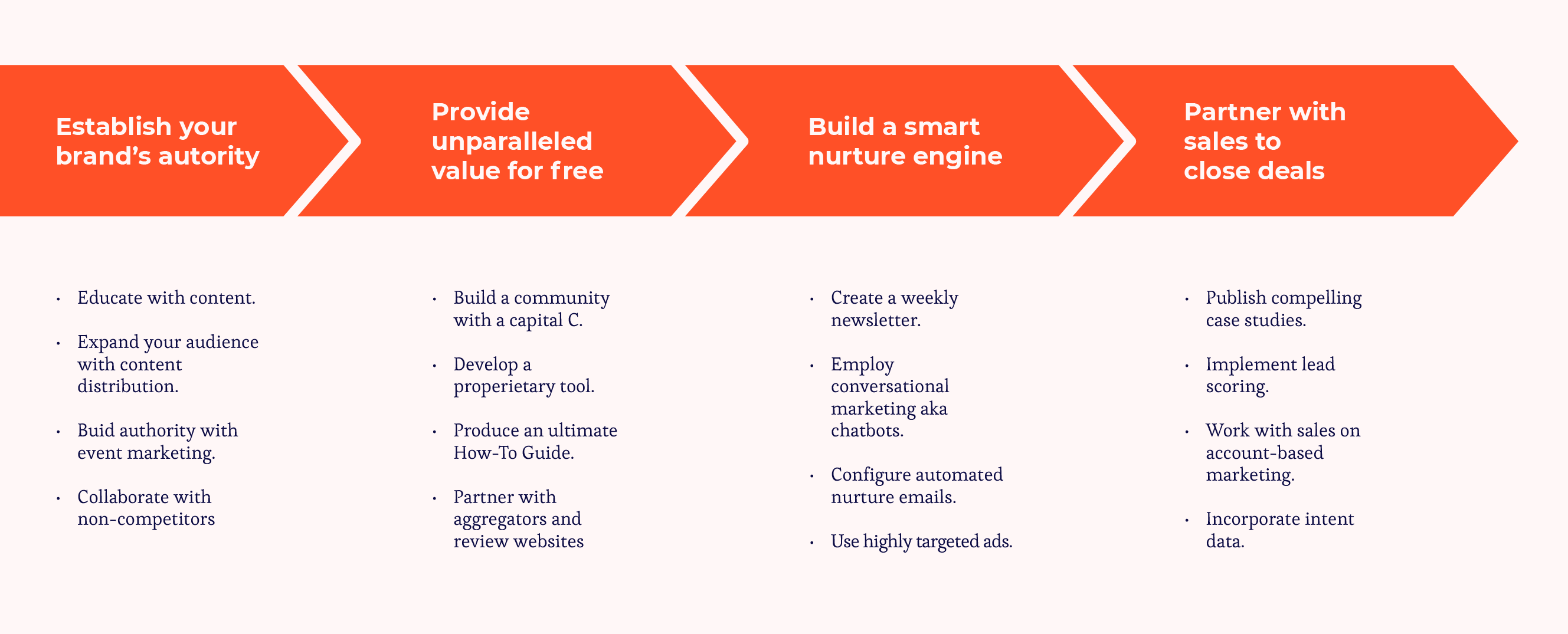
If you feel inspired, try out some strategies and tactics and leave a comment below or send me a message on LinkedIn. I want to hear about your demand generation marketing results!
Don’t miss out on the latest ecommerce insights and strategies for your business: Subscribe to The Ecomm Manager newsletter today.
More great ECM content:

